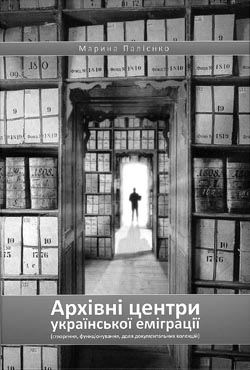Ukrainian emigre archives

Tempora Publishers of Kyiv, which is rightly called the Atlas that supports Ukrainian culture, recently issued an important publication, a monograph by Maryna Paliienko, entitled Archival Centers of the Ukrainian Emigration (The Creation, Functioning, and Fate of Document Collections).
Paliienko is an associate professor at Taras Shevchenko National University’s Department of Archival Studies, who has researched this subject for more than a decade. “This monograph is based on many historical sources that I studied in various archives in Ukraine, France, the Czech Republic, and Russia. I think the subject is very topical, considering that for many years these documents were not accessible to broad scholarly circles. These unique document collections, from which emerges a detailed picture of the Ukrainian national liberation efforts in 1917-20 and their key figures, Symon Petliura, Volodymyr Vynnychenko, Dmytro Antonovych, Dmytro Dontsov, and others, were created in the Central European countries in the 1920s and 1930s,” the author said.
During the Second World War, Paliienko says, various Nazi special services took an interest in these archives, and in 1945 some of them were transferred to the USSR. Most were sent to Kyiv’s special archives, but some remained in Moscow. Thus, documents from the archives of the Symon Petliura Ukrainian Library in Paris are stored in the State Archive of the Russian Federation and the Russian State Military Archive. “Gaining access to the latter was difficult because the Russians are loath to admit that Ukrainian materials are generally concentrated there. Access to other archives, specifically Ukrainian, Czech, and French, is open,” the Ukrainian archival specialist said.
Her monograph includes a supplement of miniature photographs, including pictures of those who headed Ukrainian emigre archival centers in various periods, such as Mykhailo Obidnyi — who was among the first to set up a Ukrainian archive in Poland, later transferred to Bohemia, Czechoslovakia — Arkadii Zhyvotko, Ivan Rudychev, Ivan Horbachevsky, and others.
“This publication is a valuable source of historical information about the national liberation struggle in the early 20th century,” said Iryna Davydko, the editor of Paliienko’s monograph, “because the government of the Directory of the Ukrainian National Republic shipped out a number of materials. These documents also illustrate various aspects pertaining to the civic, political, educational, scholarly, and religious life of the Ukrainian emigration between the world wars. It is impossible to study either Ukrainian emigre history or 20th-century Ukrainian political and cultural history without examining these documents.”
As usual, Tempora is working on several simultaneous projects. Yaroslav Okunevsky’s Lysty z chuzhyny (Letters from Foreign Lands, the fascinating travel notes about Europe, Asia, and Northeast Africa by a 19th-century writer) and Ihor Bondar-Tereshchenko’s Literaturnyi protses zadzerkallia 10-30-kh rokiv (The Literary Process behind the Mirror of the 1910s-1930s) are being readied for publication.
Yurii Tereshchenko and Tetiana Ostashko’s Ukrainskyi patriot iz dynastii Habsburgiv (Ukrainian Patriot from the Habsburg Dynasty) — about the life and activities of Wilhelm Franz von Habsburg-Lothringen — will be launched in about a month. Von Habsburg was a scion of one of Europe’s celebrated royal houses, whom Ukrainian soldiers nicknamed Vasyl Vyshyvanyi (Vasyl the Embroidered).






